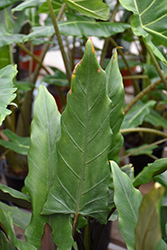Fri & Sat 8am - 8pm
Sun 8am - 7pm
Anytown, USA 12345
fax: 261.787.0463
e-mail: info@successgc.com


Plant Finder

Height: 4 feet
Spread: 3 feet
Sunlight:
![]()
Other Names: Silver Sword, Elephant Ear
Description:
Impressive, elongated and scalloped deep green leaves with contrasting purple undersides emerge in a vertical, upright and pointed habit; elegant as a commanding indoor accent; great for patio containers in warmer weather
Features & Attributes
Purple Sword Alocasia's attractive large glossy pointy leaves emerge chartreuse, turning dark green in color with curious purple undersides and tinges of coppery-bronze throughout the year on a plant with a towering habit of growth. It features solitary conical light green hooded flowers with creamy white overtones rising above the foliage from mid winter to late fall. The deep purple stems are very effective and add to the plant's interest.
This is an open herbaceous evergreen houseplant with a rigidly upright and towering form. Its relatively coarse texture stands it apart from other indoor plants with finer foliage. This plant usually looks its best without pruning, although it will tolerate pruning.
Planting & Growing
When grown indoors, Purple Sword Alocasia can be expected to grow to be about 4 feet tall at maturity, with a spread of 3 feet. It grows at a medium rate, and under ideal conditions can be expected to live for approximately 5 years. This houseplant should be situated in a location that that gets indirect sunlight at most, although it will usually require a more brightly-lit environment than what artificial indoor lighting alone can provide. It is quite adaptable, prefering to grow in average to wet conditions, and will even tolerate some standing water. The surface of the soil should be kept consistently moist all of the time, and you should expect to water this plant two or more times each week, especially if it's growing in a low-humidity environment. Be aware that your particular watering schedule may vary depending on its location in the room, the pot size, plant size and other conditions; if in doubt, ask one of our experts in the store for advice. It will benefit from a regular feeding with a general-purpose fertilizer with every second or third watering. It is not particular as to soil pH, but grows best in rich soil. Contact the store for specific recommendations on pre-mixed potting soil for this plant. Be warned that parts of this plant are known to be toxic to humans and animals, so special care should be exercised if growing it around children and pets.
There are many factors that will affect the ultimate height, spread and overall performance of a plant when grown indoors; among them, the size of the pot it's growing in, the amount of light it receives, watering frequency, the pruning regimen and repotting schedule. Use the information described here as a guideline only; individual performance can and will vary. Please contact the store to speak with one of our experts if you are interested in further details concerning recommendations on pot size, watering, pruning, repotting, etc.
-- THIS IS A HOUSEPLANT AND IS NOT MEANT TO SURVIVE THE WINTER OUTDOORS IN OUR CLIMATE --
